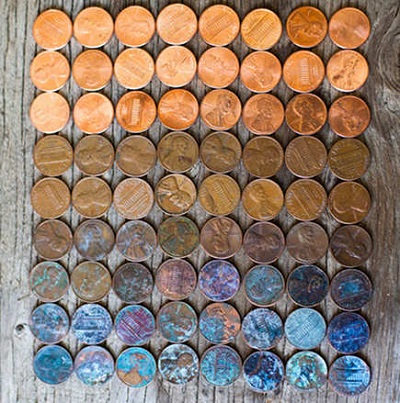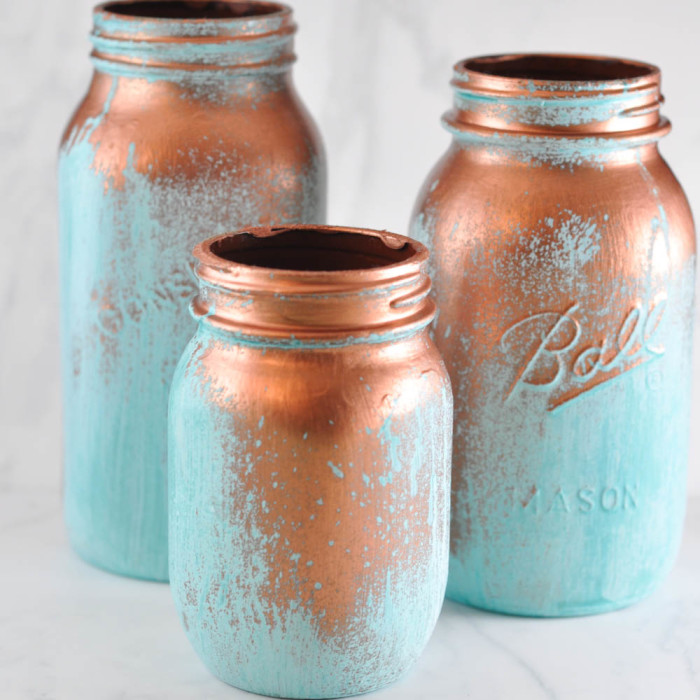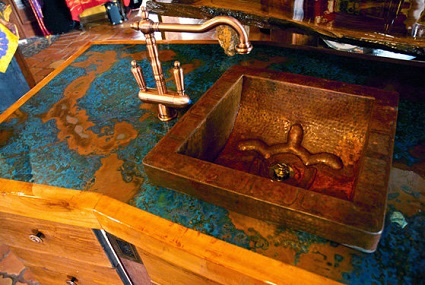To Patina or to Not Patina: Our Guide to the Highly Desired Aged Copper Look
Copper can be a luxurious enhancement to your kitchen decor. It oozes charm and old world character like no other metal and is durable, corrosion resistant and anti-bacterial. When you introduce copper into your home, whether in the form of a copper sink, a copper backsplash, copper cookware or copper mugs, you broaden the aesthetic scope of your home so that, even if your decor is aggressively modern, it will still have a timeless quality that may be otherwise lacking.
There are many ways to achieve this timeless effect with copper. One is by choosing pots and pans that have a decidedly retro design to them. Another is to introduce copper surfaces that have been worked to give them an aged look. And still another - and maybe the most popular method for achieving a timeless feel for your copper decor - is to either allow a patina to accrue naturally or to artificially promote the development of a patina yourself.
In this article not only we will we explain whether or not you should consider patina as well as explain how you can artificially promote the patina effect.
The Upside to Copper Patina
Everyone who has seen the Statue of Liberty knows what a naturally occurring patina looks like. Some love the look, others.. not so much. Here we’ll look at both sides of the patina argument and see if we can determine which one makes more sense. First the upside.
- Less Work - Without a doubt this is one of the most appealing aspects of a patina. Copper wants desperately to develop a patina and in the outdoor environment it’s practically impossible to prevent it. Indoors however it’s possible to keep your countertop, sink, Moscow Mule mugs and cookware looking shiny and new but it can be a lot of work. Simply allowing the copper to follow its own path is definitely a less labor intensive choice.
- Beauty - The natural development of a patina typically takes place over the course of several years and can involve different colors and looks depending on what corrosives the copper has been exposed to. Typically however it will gradually change from its off the shelf golden-red to various shades of dark brown and then to different shades of blue and green. All of these different looks have their own distinctive appeal that many homeowners adore.
- Versatility - A copper patina doesn’t have to be an either/or process. That is, you don’t have to choose between a sparkling new factory finish or the thick pale green you see covering old statues. You can guide the process along periodically working the finish with soft steel wool or by the application of other chemical treatments to achieve unique and stunning effects (though you’ll have to apply a sealer to lock in your final look).
Downside to Copper Patina
Now that we’ve had a look at a few of the positive aspects of letting a patina develop on your copper decor items let’s take a look at possible downsides.

- Unappealing to Some - While plenty of homeowners are pleased by the idea that letting a patina develop will free them from the work of maintaining their copper decor items, they begin to change their tune when they see the actual patina itself develop. Often it’s the deep browns, blues and greens that put them off outright, while in other cases it’s the way these colors - newly introduced into the kitchen decor - are working (or not working) with the existing color scheme.
- Difficult to Control - When it comes to copper sinks in particular it can be very difficult to control the direction the patina takes. Any acidic liquids that come in contact with the surface will alter a patina you may be trying to carefully cultivate. Same with cookware. When it comes to pure copper mugs (unlined, unsealed) they will react to the lime juice that is part of a Moscow Mule and may develop stains (patina) you find unappealing.
- Potential Health Risks - One item that may present an actual health risk is the pure copper mug mentioned above. That’s largely because when lemon or lime juice comes in contact with pure copper it causes an instant chemical reaction which on the one hand creates a stain (patina) but on the other hand causes potentially harmful chemicals to leach into your drink. For this reason alone you should always insist on sealed copper mugs or mugs that are lined with another metal like tin, and it's best to not allow a patina develop on them.
Truth be told there is no right or wrong when it comes to the aged look of your copper decor. You either like it or you don’t. There are things to be said for letting the material follow its natural course and many aesthetic pleasures to be derived from doing so. On the other hand, factory finished copper has its own lustrous appeal that, when properly maintained, will provide your home a beauty and charm that will transcend the years.
CREATING BEAUTIFUL PATINAS ON YOUR COPPER DECOR
Now that you have decided whether or not the patina effect is right for you, lets take a closer look on ways you can achieve this effect.
Some homeowners just love the warmth and glow that is given off by a shiny copper finish, and they'll do everything they can to keep it that way (if that's you, check out this blog post). But it isn't for everyone. If you're in the other "group," that still loves metallic decor items, but prefers a different type of aesthetic finish (perhaps a more aged appearance or a different color variation), then you're going to need to add a patina to the metal.
What is a Patina?
 First things first; what on earth is a patina? For those of you that don't already know, a patina is quite simply a change in the color of the metal. A patina can be created both naturally and artificially, and it's the latter that we're going to focus on during this post, since the natural process can take a lengthy period of time. In fact, you've most probably observed that process taking place in and around your home at one point in time, with items that are made out of metal (especially copper or brass) turning either a kind of cool green color or a blue. What's causing this? One word: Oxidation. It's just the metal reacting to the oxygen that it comes into contact with, and the blue or green patina that you see form is just the metal's way of protecting itself from any additional oxidation.
First things first; what on earth is a patina? For those of you that don't already know, a patina is quite simply a change in the color of the metal. A patina can be created both naturally and artificially, and it's the latter that we're going to focus on during this post, since the natural process can take a lengthy period of time. In fact, you've most probably observed that process taking place in and around your home at one point in time, with items that are made out of metal (especially copper or brass) turning either a kind of cool green color or a blue. What's causing this? One word: Oxidation. It's just the metal reacting to the oxygen that it comes into contact with, and the blue or green patina that you see form is just the metal's way of protecting itself from any additional oxidation.
How Can You Create a Patina?
As we've already mentioned, if you want your copper decor to have a patina, you want it now, not several years down the line, which is how long it would probably take Mother Nature to get the job done. There are many different techniques you can use to create a patina on your copper items, but before we go on to discuss a few of those, it's important to point out that there are also a number of variables that can affect the end result. These include the room temperature on the day that you carry out the work, the temperature and dilution of the liquid that you apply, the amount of the solution that you apply to the copper, the state of the copper prior to patination and the amount of time it is exposed to the solution. It is very hard to replicate the exact same patina on several pieces due to the sheer number of factors in play, and if this is your goal, you would be best advised to carry out the patination on these pieces on the same day, using the same solution/technique.
Techniques You Can Easily Use At Home
If you're worrying about having to use chemicals to create a patina on your copper items - don't. You don't need to have a degree in chemistry to achieve the end result you want, nor will you have buy loads of fancy chemicals; many of the solutions we're about to talk you through use ingredients you most probably already have at home somewhere.
Creating a Patina With a Hard Boiled Egg
No, this isn't a joke. We're deadly serious! Using a hardboiled egg is one of the simplest ways to create a patina that will give your copper decor more character and charm. Egg yolks have a very high sulfur content and when copper is exposed to this sulfur, it reacts and a patina will form. All you need is a bag big enough for the copper item and a couple of hard boiled eggs chopped in half. Put the egg halves in the bag with the copper, seal it tight and leave it for a few hours. The longer you leave the bag, the darker the patina will be, although if you do want a darker effect, you should reheat the eggs every so often.
Combining Ammonia and Saltwater
If it's that beautiful bright blue patina that you really want, this is the solution that you should use. Again, it's a very straightforward process. Start by taking your ammonia solution and lining the bottom of a small bowl with around half an inch. You'll then need to put this bowl inside a plastic container (one that you can seal), and cover the top of it with some plastic mesh. Then put the copper item on top of this mesh, ensuring it doesn't come into contact with the ammonia. You then take your saltwater (a 50-50 solution tends to work well) and tip it over the copper. The higher the salt content of this solution, the brighter the patina that's created will be. You then seal the container with the copper inside and leave it a few hours to let it do its thing.
The Inexpensive Vinegar Option
You almost certainly have some vinegar in your cupboards at home and you can use it to create a lovely green patina on your copper products. It differs to the way ammonia creates the patina in that the fumes alone won't achieve the desired effect; another ingredient is required in order to ensure the vinegar stays at close quarters to the copper. Sawdust is often used. You need to take your resealable plastic container, fill it with sawdust and then mix in a healthy amount of white vinegar, before placing the copper inside the container and covering it with the sawdust. Leave this for at least a few hours (or overnight if possible), before air-drying and removing the sawdust with a soft brush.
There you have it folks, three ways in which you can create beautiful patinas on your copper decor items for very little cost. You must also remember to seal your patina, and there are a whole range of products at most home improvement stores that will help you do that, with the spray type being particularly effective.
For a more unique and customized effect you can always get your Patina copper decor engraved with anything you want. Check out our options by clicking here.

 Default Currency
Default Currency
